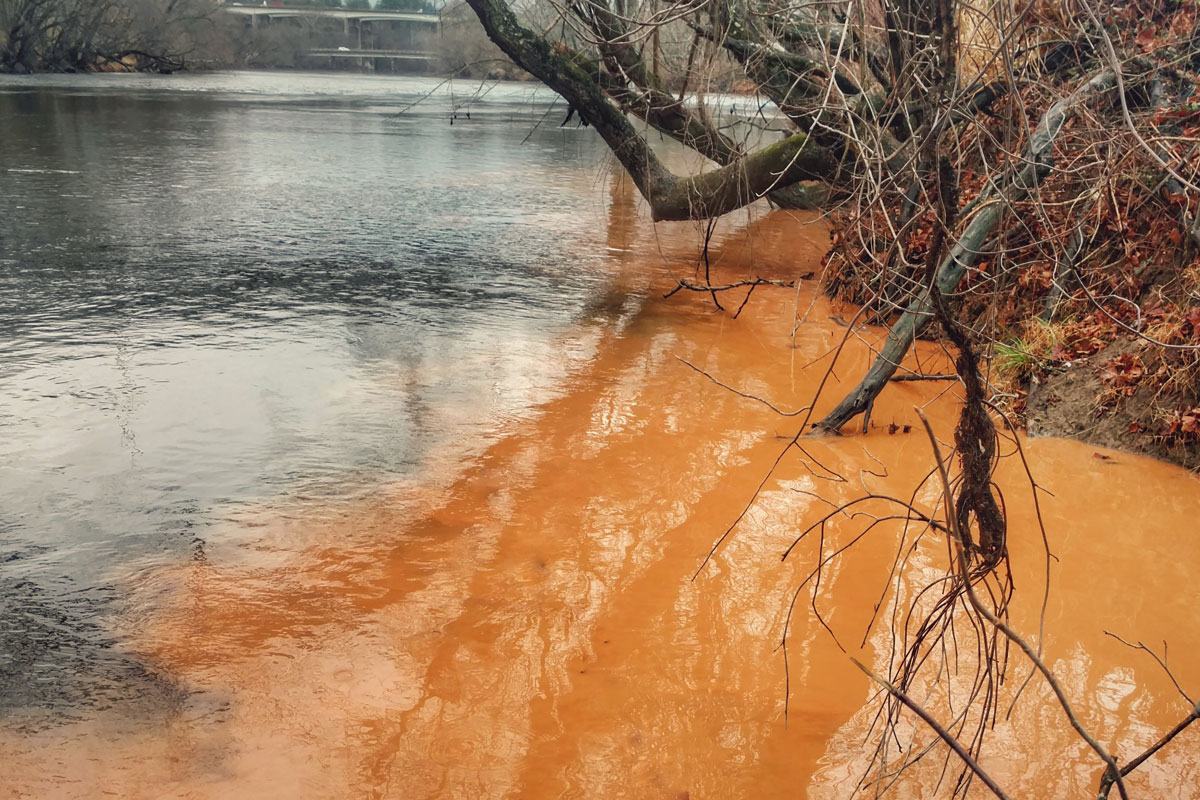
An Unhealthy Relationship
Ever wondered at the murky water of a stream or river following a rainstorm, in contrast with its clearer waters the day before? At the heart of the situation is the unhealthy relationship between stormwater runoff and sediment. Let’s examine this destructive connection and take steps for cleaner water in the French Broad system.
Sediment: The #1 Pollutant in NC Waterways
Sediment comes from many sources in our developed environments, including bare soil on construction sites, poorly maintained dirt and gravel roads, and anywhere soil is disturbed. Stormwater runoff acts as the primary transporter of sediment, carrying it from unprotected soil surfaces to the nearest waterway. The hard surfaces we humans create, coupled with exposed soil vulnerable to erosion or runoff, increases the sediment load that enters our waterways.
The negative effects of excess sediment means reduced sunlight for aquatic plants, less oxygen for aquatic animals, and a rise in water temperature, with ripple effects for all living things in the stream. Sediment buildup on the stream bed degrades this essential habitat for aquatic insects, fish, amphibians, and other wildlife. Pollutants such as heavy metals, excess nutrients, and bacteria attach to sediment particles and are carried downstream.
The excess sediment in our streams results in increased turbidity – a measurement of how clear the water is. Clear, colorless water has a low turbidity; murky or muddy water has high turbidity, an indicator of the amount of sediment particles suspended in the water. Turbidity is a great indicator of water quality – not just for the presence of soil particles, but also for bacteria and other contaminants. From May to September, clean water agencies use turbidity to measure bacteria levels in the French Broad River at Pearson Bridge. Learn more here.

Did You Know?

Sediment is the most common pollutant for our urban waterways.
Eroding Our Future
As you stroll alongside a stream on your property or a nearby park, have you noticed chunks of soil and vegetation disappearing from the stream’s edge? Streambank erosion refers to the gradual removal of soil, rock, and vegetation from a stream bank, creating a channel or gully. Erosion is a natural geological process, but again – stormwater runoff from impervious surfaces (parking lots, rooftops, and roads) amplifies the volume and velocity of water entering the nearest stream, resulting in excessive erosion. In urban and other developed areas, this fast-moving water can speed up the erosion of stream banks, changing the landscape faster than we might realize, and damaging freshwater ecosystems downstream. This is especially true for streambanks that lack woody plants to hold the soil in place.

Did You Know?

According to the Environmental Protection Agency, sediment pollution causes $16 billion in environmental damage annually.
Riparian Buffers – Nature’s Sponge
Trees, shrubs, and native grasses help keep soil intact! One way to reduce sediment is to protect and maintain the plants growing alongside our streams. Riparian buffers are the vegetated areas located along the banks of streams, rivers, wetlands, and lakes. A healthy riparian buffer consists of native trees, shrubs, and grasses that act as a natural barrier between land and water. Riparian buffers play a critical role in protecting water quality by filtering pollutants, reducing erosion, and preventing runoff from flowing into our waterways. Additionally, they provide wildlife habitat, improve flood control, stabilize streambanks, moderate water temperatures (trees provide shade), and enhance climate resilience.

Did You Know?

The French Broad River Basin includes 4,136 stream miles. As our region continues to develop, we must ensure that our streams have at least a 30-ft. buffer of woody plants to slow and filter runoff and prevent erosion.
Beneath the Surface: Hidden Gems
The French Broad River is teeming with small creatures, each species playing a vital role in maintaining ecological balance. Yet many aquatic organisms are highly sensitive to changes in water quality. Sediment pollution has caused a persistent decline in water quality and negatively impacted populations of sensitive aquatic species. Some of the animals that historically contributed to our aquatic ecosystems but now confront this water quality challenge include:
- Gilt Darter – The Gilt Darter requires cool, fast-flowing streams with clean gravel or rubble riffles and aquatic plants to host its prey: aquatic insects like mayflies. Grab a mask and look for them in upper French Broad streams!
- Eastern Hellbender – The Eastern Hellbender is one of only three giant salamanders found in the world. Hellbenders breathe through their skin, making them susceptible to sediment and other pollutants in their aquatic habitat. Hellbenders shelter in the spaces underneath rocks and when excess sedimentation fills in these spaces, they lose this vital habitat.


Did You Know?

There are more than 65 species of salamanders that live in North Carolina, with over 50 in the mountain region alone; all depend on clean water.
How Can You Reduce the Burden on Our Streams?
Allow stormwater to soak into the ground; eliminate runoff from your property
- Install rain barrels to capture and store rainwater for later use. Look at our Rain Barrel Guide.
- Disconnect your downspout and redirect runoff away from paved surfaces to a vegetated area. Check out our Guide to Disconnect your Downspout.
- Build a rain garden to capture and filter runoff. Look at our Rain Garden Guide.
Refrain from mowing or cutting down vegetation on stream banks
- It is good practice to allow vegetation to grow in the 30-foot buffer on each side of a stream, reducing erosion as the plants help hold the soil in place.
Plant native trees or shrubs along waterways
- Plant native woody plants that are naturally adapted to grow near streams. Some small tree species that grow quickly are silky dogwood (Cornus amomum) and silky willow (Salix sericea). Some taller tree species are river birch (Betula nigra) and yellow buckeye (Aesculus octandra).
Develop a plan to retain soil on site during home building projects, and preserve existing vegetation
- Even small home building projects can produce sediment runoff. Leave vegetation in place wherever possible. Implementing a cover crop such as clover over exposed soil is also a good way to minimize erosion and sediment runoff.
Resources
- Riparian Plants for Streambank Stabilization
- Backyard Stream Repair Guide
- Stop Erosion- Solving Drainage and Erosion Issues

How Can You Help?
Ready to learn more? Head over to our Take Action page to learn more about simple ways you can reduce rain runoff at your residence or business.
